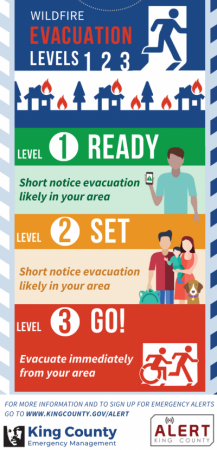Understanding Evacuation Levels
Ready, Set, Go! An all-hazards approach to evacuation messaging.
In an effort to simplify evacuation messaging, King, Pierce, Snohomish, and Thurston Counties launched “Ready, Set, Go!” a regional evacuation readiness program.
When an emergency warrants a potential evacuation, the City of Mercer Island will follow the Ready, Set, Go! evacuation levels.
"Ready" Phase – Level 1. Be aware of the danger in your area and start preparing for possible evacuation.
- Monitor City information channels and local media.
- Check on neighbors.
- If you do not already have an evacuation plan or a go-kit, assemble or update these now.
- Prepare both the inside and outside of your home.
- Leave if you feel unsafe -- do not wait for an official evacuation order.
"Set" Phase – Level 2. Be prepared for sudden or short-notice evacuation.
- People who need help or more time to evacuate -- such as people with disabilities, people with small children, people with medical conditions, and people with large animals -- should evacuate now.
- Ensure your evacuation plan checklist is complete and that your go-kit is in your vehicle.
- Stay informed and be aware of alerts from local law enforcement and fire departments.
- Always remember to leave if you feel unsafe, do not wait for an official evacuation order.
"Go!" Phase – Level 3. Go now!
- Danger in your area is current or imminent and you should evacuate immediately.
- Follow directions from law enforcement or fire departments and do not return home until officials have determined it is safe.
- Notification that it is safe to return home will be given as soon as possible.
Print the Ready. Set. Go. flyer
Emergency Notifications and Communication
During an emergency, notifications will be shared with the community across all of the City’s communication channels including:
- Emergency alert system. Our emergency alert system, known as Red Alert or ALERT King County, will be activated and information will be pushed out to cell phones via a phone message, text, and/or email. Sign-up or sign-in to your account today to make sure your information is up to date: www.mercerisland.gov/emergencyalert.
- City Website. Information will be posted as a red alert banner at the top of the City website - www.mercerisland.gov. When activated, the emergency banner is static and will appear on all City webpages. When the banner is live, click on it to open details.
- Facebook, NextDoor, and Twitter. The communications team will push out updates on social media. Start following the City’s social media channels now so you receive those alerts as they happen.
- City Information Line. The City’s information line (206-275-7600) is staffed Monday through Friday, 8:30am – 5:00pm and is answered by a member of the City team. During an emergency the City will likely extend those hours. If possible, check the City website for information first, before calling the information line, then call the information line or email the Customer Service Team if your questions have not been answered or if you have information to share with the City: 206-275-7600 or customerservice@mercerisland.gov.
- Electronic Message Boards. Electronic message boards will be placed along key City arterials, highlighting emergency information.
- Live YouTube Briefings. When possible, the City will host live briefings on the City’s YouTube channel: www.youtube.com/mercerislandcouncil. Those will be available for viewing after the live event on YouTube and MI-TV Channel 21.
- Local Media. During a large-scale emergency, information will be passed through to local media including MI High School Station FM 88.9.
- Loudspeaker. If power is out and/or evacuation is eminent, City vehicles – not responding to the emergency – that are equipped with speakers and/or sirens will be deployed across the Island to alert neighborhoods of the situation.
- HAM/Amateur Radio Operators. During a major disaster, the City may also rely on the Mercer Island Radio Operators (MIRO), a group of dedicated, resident-volunteers who are trained to provide back-up communications and support to the City during major disasters.
- Neighbor-to-Neighbor and Business-to-Business. YOU are an important part of the communication chain during an emergency. Contact friends, neighbors, and colleagues to make sure they know the latest information. Get to know your neighbors and share contact information before disaster strikes. Neighborhood block parties and Map Your Neighborhood are great ways to get started.

